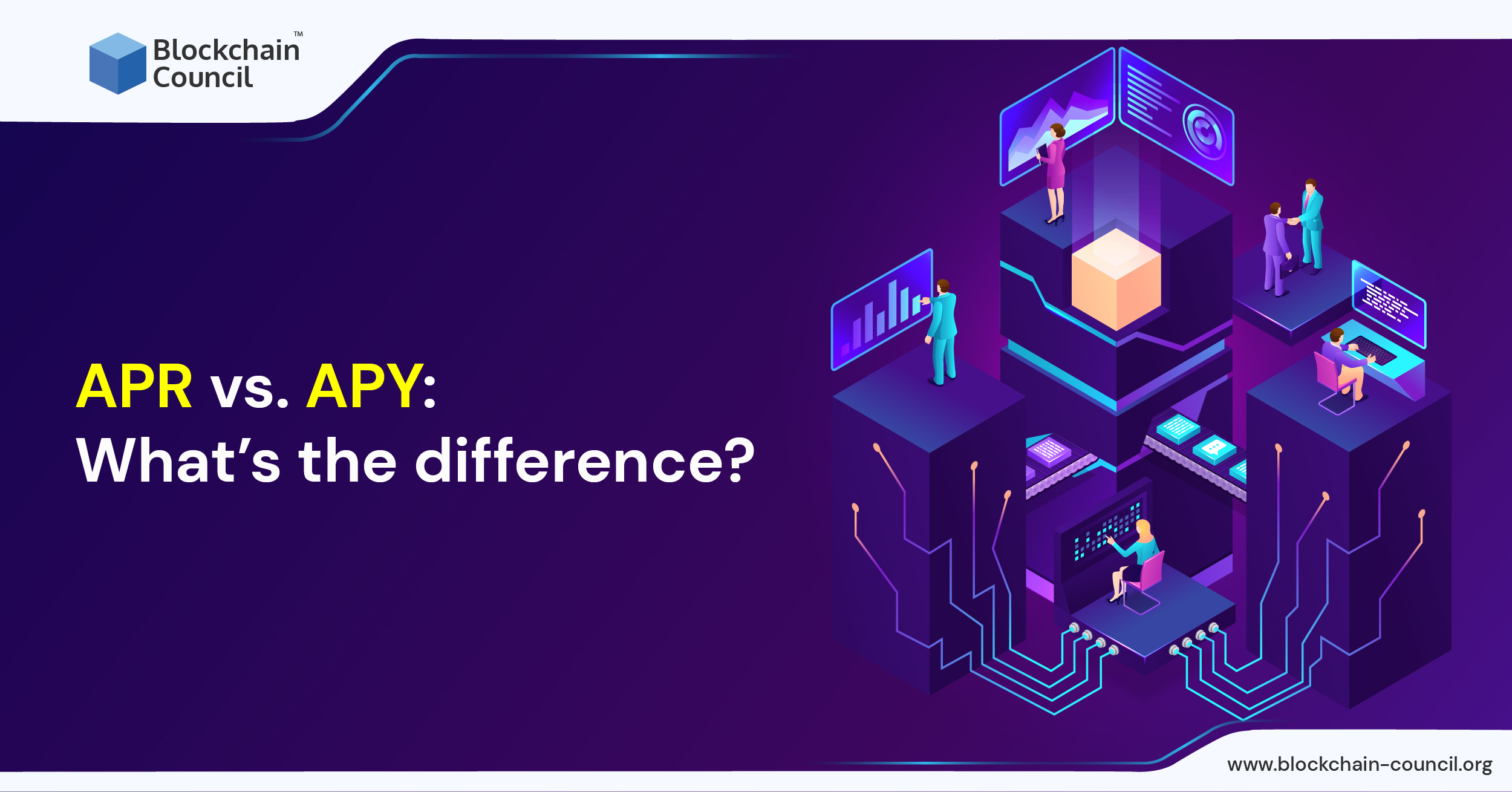
- Blockchain Council
- October 31, 2022
Those who dabble in finance, especially personal finance, might know the two key terms – APR and APY. These terms are often confusing for beginners just exploring and learning about personal finance. These terms are used to calculate accumulated investment and other credit products’ interest. They can heavily influence your earnings or payments when applied to account balances.
You should be aware that APR and APY are pretty different and are neither equal nor the same. Let us know about the two terms in-depth and understand the key differences.
What is compound interest?
First, Let us understand compound interest. In simpler terms, compound interest means the interest being paid upon the prior interest. Suppose your bank decides to give you interest as per compound interest. In that case, they will look at a new figure every month to determine the interest, which can fluctuate the compound interest formula.
APR – Annual Percentage Rate
APR stands for annual percentage rate. This is the simpler of the two terms. In simple terms, the Annual percentage rate is the interest a lender is bound to earn on their money. Also, the borrower pays for the interest over one year.
Let us look at an example.
You recently opened a savings type of bank account with an initial saving amount of $1,000 already deposited in it. The Annual percentage rate or APR for the amount in the savings bank account is set at a reasonable rate of 20%. According to this, you’ll be paying an interest amount of $200 after a year passes. The interest you’ll pay after a year is calculated by multiplying the initial principal amount by the annual percentage rate (APR).
In this case, the initial principal amount is $1,000, and the APR is 20%. By multiplying the two, you’ll be bound to pay a total amount of $1,200. This amount will increase accordingly. Here, the initial principal amount will climb to $1,400 and then $1,600 after the third year passes.
You’ll notice how a fixed amount of $200 (calculated during the initial amount involved) adds up yearly. This needs to be kept in mind as simple interest occurs here.
What is APR in crypto?
Cryptocurrency developers and their subsequent lenders also make money by lending their crypto. Unlike traditional loans, here, other miscellaneous expenses are to be paid by the borrower but not compound interest.
APR is simple, with no hidden expenses whatsoever. The interest is calculated only on the initial loan amount and is fixed.
Now, let us look at the more difficult and much different term- APY.
APY – Annual Percentage Yield
APY stands for Annual Percentage Yield. Unlike in the APR model, where you get a fixed amount after every year, which is decided upon by the initial principal amount itself, in the annual percentage yield, you will receive some interest every month.
Another term for APY is earned annual interest, which is compound interest.
Now, come back to the $1,000 lying in our savings bank account. If we apply the calculated method of APY, the interest will be added by the bank monthly, and at the end of the year, you’ll be left with $1,249. That’s $49 more than what you received with the APR method.
This is the power of APY. While being more complicated, it gives better results. After three years, the $1,000 would have been converted into $1,813, a decent amount of $213 more than what we’ll receive from the AYP method.
What is APY in crypto?
APY is the same in crypto as in traditional money lending systems. Here, the loan amount is Cryptocurrency. Developers and cryptocurrency expert advisors often choose the annual percentage yield as it simply provides the lenders with more money. Investors can use crypto exchanges, crypto wallets, or any blockchain platform to start earning an APY on their Bitcoin. They stake their coins and use the yield farming method to supply liquidity to liquidity pools. This is precisely why APY is more practical and profitable than APR, at least when it considers cryptocurrency experts.
To understand more about this in-depth so that you actually can start earning by this, you’ll need to learn crypto trading in depth.
Key Differences between APR and APY
| APR | APY |
| APR is inclusive of all charges | APY calculates interest rates only |
| It does not carry the compounding principle | It follows the compounding principle |
| Amount in APR ranges variably | Amount in APY remains constant |
| It is usually associated with credit accounts | It is generally associated with deposit accounts |
Here are some of the critical differences between APR and APY –
- Annual Percentage Rate(APR) takes into account fees and other costs related to a loan or investment and calculates the interest price, including all charges. In contrast, the Annual Percentage Yield calculates the interest rate, which factors the compounding frequency.
- APR can sometimes factor in the frequency of compounding as well. On the other hand, APY solely considers the power and effect of compounding and nothing else.
- As quoted by leaders, ‘APR is the interest rate you’ll pay if and when held until the loan is paid off at the scheduled time. The annual percentage rate is typically different in each year of the loan. In the case of APY, it is dependent on the formulae and calculation. APY is the same in the first year of the loan, the last year, and each year in between.
- APR is more practical and informative with credit accounts. APR is a little less valuable and informative with deposit accounts, but it typically depends on your usage.
Let us look at an even more specific example.
Suppose that you enrolled for a credit card from a financial bank. That credit card charges an interest rate of 1% every month. That would automatically translate into an interest rate of 12% on an annual basis.
This is not the case with APY, which considers compound interest. Here, the APY for an interest rate of 1% would be 12.68% for an entire year. If you carry the same balance on your credit card for a month, you’ll be charged a rate equivalent to 12%. However, if you hold it for a year, you’ll have to pay interest worth 12.68%, which is .68% more than what you’ll be spending in the annual percentage rate or APR.
-
The borrower’s perspective
When you are a borrower, you’re looking to get the lowest possible interest rate while taking money or any loan from the market. So, when you look at APR and APY, you should typically be aware of the different ways a loan might be disguised as having a lower interest rate.
So, when looking for a loan in the market, you will pick someone who offers the lowest interest rate. But, even though the quoted rates may appear soft, you can land in such a situation where you’ll be paying much more for the loan than you initially thought you’d pay.
This is because the bank would give you the loan’s annual percentage rate without mentioning whether it was compounded semi-annually, quarterly, or monthly.
So, if your bank quotes you an interest rate of 5%, you’ll pay 5.11% each year. This is because banks and other borrowers or financial institutions do not consider or disclose the effect of compounding on loans.
Also, while looking for a loan, you should look at other lenders’ loan quotes and what you’ll be paying.
-
Lenders Perspective
You are on the opposite side of the borrower. When a borrower makes an informed decision, you’ll be heavily affected if you plan to tell the borrower of the simple interest instead of considering the compound interest.
By nature, those who seek loans want to get them at the lowest rate possible. Likewise, those who will be lending loans will also wish to Lend (or receive interest if you deposit money in a bank account that will give you interest) at the highest possible rate.
Just make sure to take a good enough look at how often compounding occurs on your lent money. Additionally, contrast those with APY rates from other banks that compound at a comparable rate. It can significantly affect the amount of interest your savings could accrue.
APR vs. APY In Crypto: Which Is Better?
In cryptocurrency trading, APR and APY are very much the same. APY only considers simple, ordinary interest, while APY includes compound interest. So, APY is regarded as the better pick.
Conclusion
APR and APY are crucially essential concepts to understand for much more effective and efficient management of your finances. The difference between APR and APY widens much more when usually the interest is compounded more frequently. Be aware of the various rates offered when looking for a loan, applying for a credit card, or trying to get the highest rate of return on a savings account.
Usually, Financial institutions quote different rates to different people; their motives depend hugely on whether you are a borrower or a lender. You need to make sure you understand the rates. They are being quoted by these financial institutions and subsequently look at different, comparable rates from other institutions. The difference in the amount will surprise you—and the lowest advertised rate for a loan can turn out to be the most expensive.





































































 Guides
Guides News
News Blockchain
Blockchain Cryptocurrency
& Digital Assets
Cryptocurrency
& Digital Assets Web3
Web3 Metaverse & NFTs
Metaverse & NFTs
